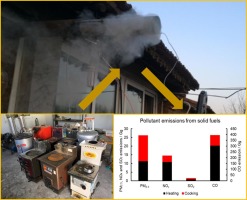Environment International ( IF 10.3 ) Pub Date : 2020-03-07 , DOI: 10.1016/j.envint.2020.105608 Mengsi Deng , Pengchao Li , Rongjiang Ma , Ming Shan , Xudong Yang

|
Solid fuels used for heating and cooking in rural households cause a large amount of pollutant emissions. Actions are being taken to replace these solid fuels with cleaner energy carriers. However, the pollutant emission amounts from solid fuels over large areas have rarely been evaluated. In this study, we tested eight common heating stoves consuming bituminous coal chunk, anthracite coal chunk, and anthracite coal briquette; three honeycomb briquette stoves; and three traditional cookstoves consuming corn straw and wood in rural Beijing. Emission factors of particulate matter with aerodynamic diameters ≤2.5 μm (PM2.5), carbon monoxide (CO), nitrogen oxide (NOx), and sulfur dioxide (SO2), were measured as 0.08–13.74 g/kg, 10.80–148.5 g/kg, 0.52–8.44 g/kg, and 0–0.85 g/kg, respectively, for coal heating stoves; 0.35–1.11 g/kg, 16.10–109.43 g/kg, 0.51–0.75 g/kg, and 0–1.98 g/kg, respectively, for honeycomb briquette cookstoves; and 5.90–11.79 g/kg, 28.96–50.23 g/kg, 1.52–2.46 g/kg, and 0–0.05 g/kg, respectively, for traditional biomass cookstoves. Combining emission performance and solid fuel consumption, the estimated annual PM2.5, CO, NOx, and SO2 emission amounts were 26.18 Gg, 394.07 Gg, 14.56 Gg, and 1.53 Gg, respectively. The results present useful information regarding the emission inventory of common solid fuels in rural Beijing on a city-scale. This study provides an example for future intervention projects and environment evaluation in the rural areas of other cities.











































 京公网安备 11010802027423号
京公网安备 11010802027423号